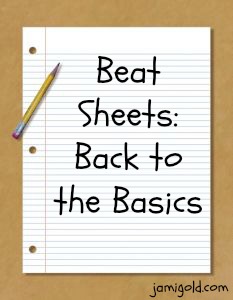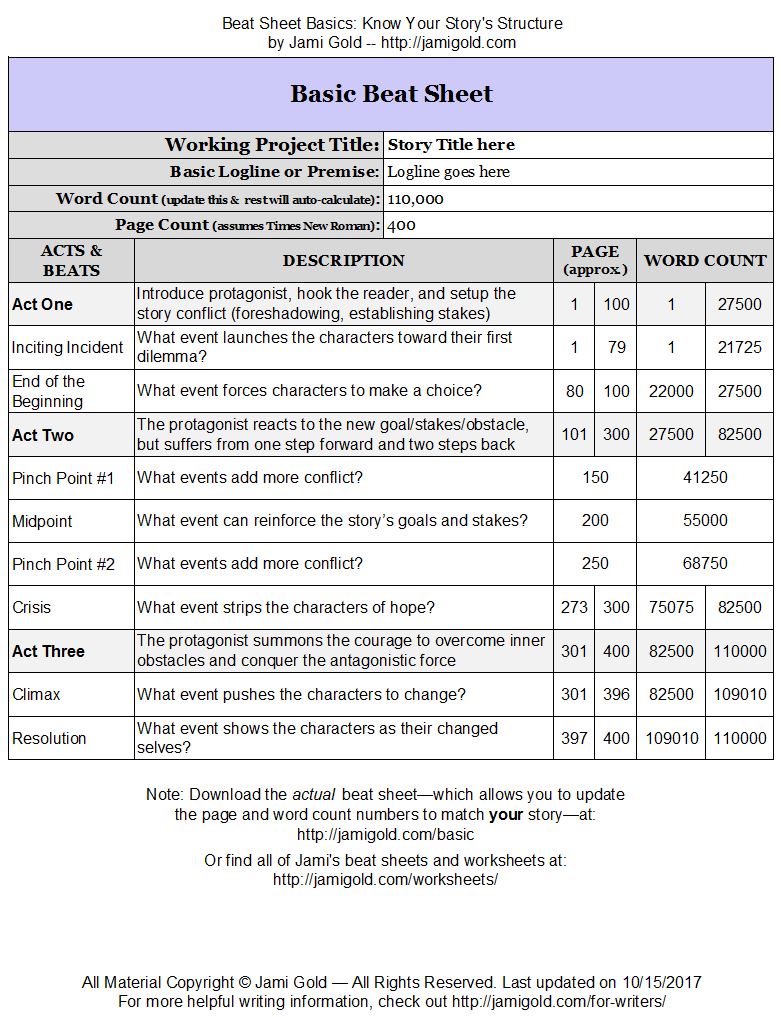It’s no secret that I’m a fan of story structure. I’ve created several beat sheets and have oodles of posts about the topic.
But I’m also not a math person, so the idea of working in Excel for all those worksheets gave me the heebie-jeebies at first. I’m probably not the only one.
It doesn’t help that beat sheets use labels that seem like a foreign language. Or that every story structure system, from Blake Snyder’s Save the Cat to Larry Brooks’s Story Engineering, all use different labels. Given all that confusion, it’s no wonder that the thought of using beat sheets can make our eyes cross.
Forget Fancy-Schmancy, We Need Non-Intimidating
Yet beat sheets can also be very helpful. For those who plot their stories in advance, beat sheets provide the opportunity to find and fix problems before drafting a word. For those who write by the seat of their pants, beat sheets can be invaluable too, both for light pre-planning and for revising the draft into shape.
With that in mind, maybe a stripped down version of a beat sheet would help. One that contains only the most important beats. One that doesn’t care about the labels. One that even the most intimidated author could use with ease.
Beats Are Not Created Equal
Considering all those different labels from the different story structure systems, it seems like there’s no way we could make them play nicely together. But no matter the label of a beat, if we strip away the mumbo-jumbo, we discover that different story structure systems include beats that serve essentially the same function. Why is that?
Well, beats are simply plot events that change the course of a story. Some plot events change a story’s direction more than others. We even call them “Turning Points”—because the story turns to focus on a new conflict, obstacle, stakes, or goal.
The 4 Major Beats
If we rank beats by how much they change the story’s direction, we see that different story structure systems agree for the most part on the major beats, those that really have an impact. We all probably know these without thinking too hard. Most stories will have:
- a starting point for the main conflict:
- an event that drags the protagonist into the situation —or—
- an event that forces a choice to get involved.
- something near the midpoint:
- an event that changes the protagonist’s goals/choices —or—
- an event that adds new stakes to the situation.
- something near the three-quarter mark:
- an event that steals the protagonist’s hope for a solution.
- an ending point for the main conflict:
- an event that forces the protagonist to face the antagonist.
The Minor Beats
The minor beats then fill in the blanks left between those 4 plot events. Only some of the systems include these, but if we like more direction with our stories they’re helpful to include, as they also change the story’s direction by a decent amount.
So although these aren’t required for any story, most stories will have:
- an event that starts the protagonist on the path toward the conflict.
- at least two events that reveal more about the antagonistic forces or increase the stakes.
- an event in the final scene showing how the protagonist has changed.
(In regards to that middle bullet, note that most stories will include more than just two scenes of conflict, but we’re talking about the scenes that change a story’s direction. Not all scenes with conflict will do so.)
Everything Else? Eh…
Everything else, all the other beats on a beat sheet, that’s where the different story structure systems really start to argue. At that point, the secondary beats often reflect more about the system author’s philosophy on storytelling than about storytelling “must haves.”
They might want us to emphasize the theme or the “B” story or something else. But those plot events don’t change the direction of the story (at least not by a large amount), so we don’t need to know them in advance, even if we’re a plotter.
Those who want to plot out every scene in advance might find them useful, but they’re not necessary for understanding or planning our story. For those who pants their story, the other beats are just clutter and confusing.
Confused by Beat Sheets? Stick with the Basics
As a pantser, when I think about beats pre-drafting, I might have vague ideas for the major beats (which often change during the drafting process). I might even have some vague ideas about the minor beats. But I definitely don’t need the clutter of everything else.
That’s my philosophy. That’s what I use in my “Lost Your Pants?” workshop and that’s what I cover in my “Beat Sheet Basics: Know Your Story’s Structure” workshop.
In addition to helping pantsers, this “back to basics” approach might help those who find beat sheets intimidating. Rather than trying to fill out every possible beat and keeping them all straight, writers new to beat sheets could start with a stripped down version, with just the beats that most systems agree on. Those beats are that common because they’re more integral to basic storytelling structure.
Introducing a “Back to Basics” Beat Sheet
In preparation for my WANACon presentation, I created a new beat sheet, the Basic Beat Sheet. This one sticks to just those 4 major beats and 4 minor beats listed above. That’s it. No clutter.
Jami Gold’s Basic Beat Sheet (for MS Excel ’07/’10 (.xlsx) version)
Jami Gold’s Basic Beat Sheet (for MS Excel 2003 (.xls) version)
(Look at how short that thing is. Two-thirds of a page. I’m serious about the “no clutter” claim. *grin*)
So if you’ve found beat sheets intimidating before, check out this one. Like all of my beat sheets, the Basic Beat Sheet handles all the word count/page count math for checking our pacing too. Just fill in the word count (estimated or actual) up top, and the rest auto-adjusts.
If you want to test out using a beat sheet to see if they help your writing process, maybe start with this one that covers just the basics. If you want a beat sheet with more options, check out my full collection of beat sheets.
(I provide choices so everyone can find the tool that helps with their writing process. Or I’m a worksheet addict. One of the two. Or possibly both.)
And if you’re a pantser or you just like my philosophy of sticking with the basics, especially before drafting, check out my more advanced “Lost Your Pants?” workshop. *smile*
Registration is currently open for my workshop on how to do just enough story development to write faster, while not giving our pantsing muse hives. Interested? Sign up for “Lost Your Pants? The Impatient Writers Guide to Plotting a Story.” (Blog readers: Use Promo Code “savethepants” to save $15 on registration.)
Do you find beat sheets intimidating? Do you know how to use them? If you’ve used beat sheets before, do you figure out every beat? If you skip some beats, which ones do you skip? Do you think a stick-to-the-basics beat sheet might be helpful? Do you have any questions about either of my workshops or about WANACon?
P.S. Are you new to beat sheets? Check out my Beat Sheets 101 post.
P.P.S. Use Scrivener? I have a matching Scrivener template for this beat sheet.


